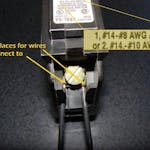When a temperature and pressure (T&P) relief valve at a water heater leaks, it's usually a simple fix; just replace the valve. These valves cost less than $15, and replacing the valve is a very basic job - just drain some water out of the water heater, remove the discharge tube, and replace the valve. No big deal.
Unless it starts leaking again.
If a recently replaced T&P relief valve starts leaking again, it probably means that the relief valve is only doing it's job; it relieving excess pressure in the water heater. When this happens, the fix gets a little bit more involved. I'll explain.
When a water heater heats up the water in the tank, the water expands. When this happens, the water typically ends up expanding back out the cold water inlet, all the way back to the water supply coming in to the house. The municipal water supply for the house acts as a gigantic expansion tank... and nobody notices. This is illustrated in the diagram below.
What would happen if a one-way valve, or check valve, was installed on the water supply piping for the house? The water wouldn't have anywhere to go. As the water heater heats the water, it expands, which builds up pressure in what is now essentially a closed system. When the pressure builds up enough, the T&P relief valve on the water heater just does it's job and relieves the excess pressure by leaking a little water.
In Minnesota it's rare for a check valve to be installed on the water supply line for the house, but it's fairly common to have a pressure regulator installed. When the pressure from the water supply coming in to a house is too high, a pressure regulator needs to be installed on the water main, to prevent damage to the plumbing components in the house. The problem that these regulators can create is that they will act as a check valve; they'll allow water in to the home, but they won't allow water back out. This creates what is called a 'closed system'.
When this happens, the T&P relief valve for the water heater can leak. This doesn't happen every time a pressure reducing valve is installed, but there may be other problems that show up in the house, such as the toilet fill valves randomly re-filling toilets, or faucets chronically dripping.
The Fix When a closed system exists on the water distribution piping in a home, an expansion tank needs to be installed somewhere on the plumbing system. This is a fairly simple and straightforward fix; an expansion tank will give the water somewhere to go when it expands, and the T&P relief valve on the water heater will stop causing problems.
This rule also applies to hot water heating systems; when a boiler heats the water in a hydronic heating system, the expansion tank allows for the water to expand without the pressure relief valve leaking. If the pressure relief valve on a boiler system chronically leaks, even after replacement, it probably means there is a problem with the expansion tank.
Reuben Saltzman, Structure Tech Home Inspections - Email - Maple Grove Home Inspector




